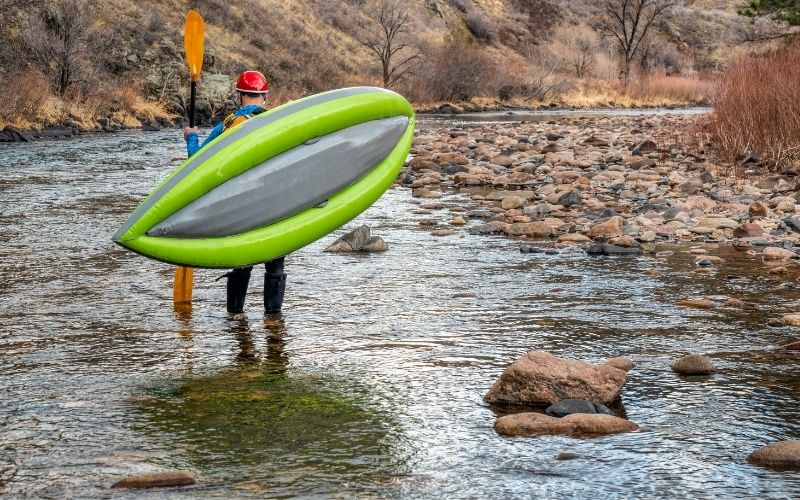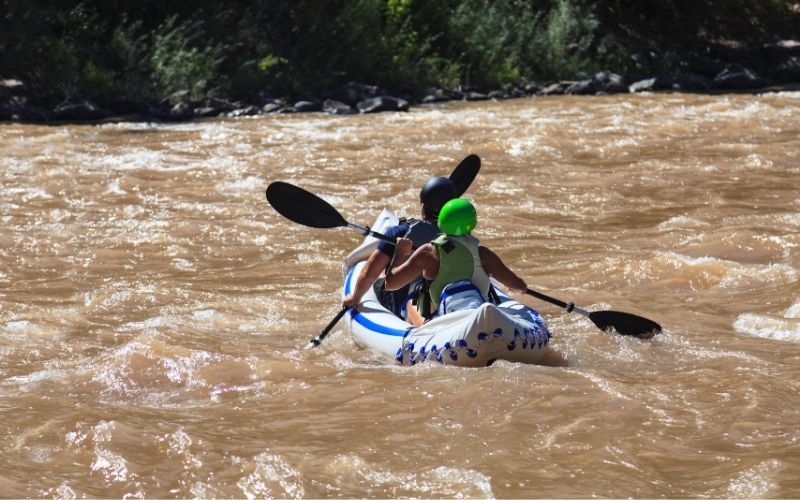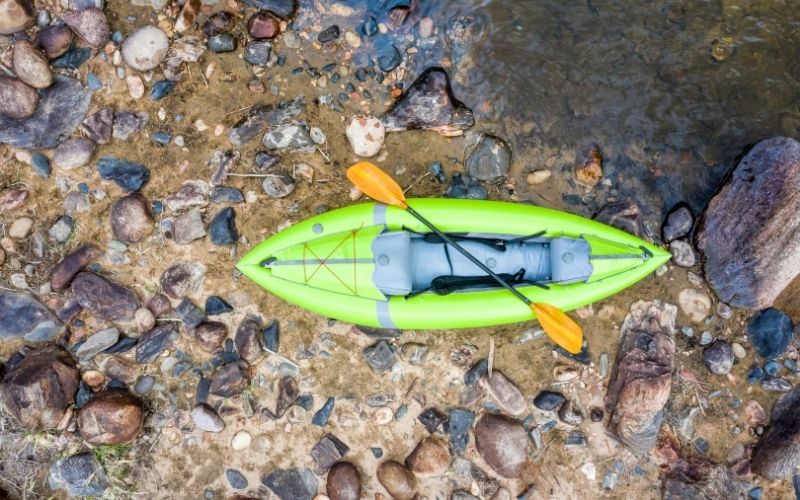You just bought yourself a brand new inflatable kayak and you’re ready to hit the water. Part of the fun of kayaking is going over river rapids and paddling through tight spaces, but there are usually rocks in these areas.
Can inflatable kayaks go over these rocks, or will the rocks tear holes in the kayak material? Are some rocks more dangerous than others?
Just how durable are inflatable kayaks? Can you trust them to handle all the abuse you might inflict on a regular kayak?
Keep reading!
In this article, we’ll answer all of these questions and more.
Table of Contents
Can Inflatable Kayaks Go over Rocks?

Inflatable kayaks are far more durable than you might expect; but are they strong enough to go over rocks? Or will rocks tear holes in the material?
The short answer is, it depends on how sharp the rocks are and the quality of the kayak. Let’s explore this answer a little further.
As you might imagine, you wouldn’t want to go over sharp rocks in a cheap inflatable kayak. For that matter, you probably wouldn’t want to go over sharp rocks at all.
When it comes to inflatable boats, you generally get what you pay for, and some of the more expensive ones may be strong enough to handle even the sharpest rocks without puncturing. But if you’re going to spend that much money on an inflatable boat, do you really want to take the risk?
Of course, when you’re in a kayak, most often, the water is going to be fairly shallow. In these cases, you will most likely go over some rocks sooner or later.
The good news is, rocks at the bottom of rivers or streams are usually smooth and, in most cases, will pose no problems for your inflatable kayak.
If you’re going over smooth rocks, the biggest risk you may face is damaging the skeg on the bottom of the kayak.
Also, if the kayak is weighed down more than it should be, with too much gear or too many passengers, you may scrape the bottom pretty hard, which could damage the floor material and cause it to deflate.

To prevent this from happening, make sure you know the weight limit for your kayak and take care not to overload it.
Try to avoid sharp rocks, especially those sticking out of water–these will probably be more jagged than any you may encounter under the water. Again, those under running water are typically smooth. Those sticking out maybe sharper because they haven’t eroded as much.
Also, rocks sticking out of water can damage not just the floor or your kayak, but the sides as well, possibly causing the kayak body to deflate.
Again, going over smooth rocks underwater is typically okay as long as you’re not scraping the bottom too hard, though be careful not to damage your skeg. Rocks sticking out of the water can do more damage to your kayak, so try to stay away from them.
Keep your eyes open for any sharp rocks sticking out above or hiding just below the water’s surface. And, if possible, it’s best to stick to deeper waters where contact with rocks is unlikely.
How Durable are Inflatable Kayaks?

Most inflatable kayaks are made to be fairly durable, though not all are created equally. Some inflatables are more high-quality than others. If you buy a cheap inflatable kayak, you’re probably going to get what you pay for.
Inflatable boats are frequently made out of PVC or vinyl materials. Sometimes they are built of rubber or a more durable hybrid material such as Hypalon.
Regardless of the material used, most inflatable kayaks are made to withstand some impacts. The technology of inflatable boat materials is improving and these types of boats are being made better and better.
That said, even the highest quality inflatable boat is not invulnerable. They can be damaged by rocks and other sharp objects, overinflation, and exposure to the elements. They must be taken care of for them to last.
Will an Inflatable Kayak Pop?

Inflatable kayaks can pop, especially if they are over-inflated or overloaded. They may also pop if they contact sharp rocks that tear holes in the inflatable chambers.
Most often, inflatable boats pop because they have been over-inflated. Over-inflation puts stress on the seams and valves of inflatable boats and can cause these relatively weak areas to fail.
You shouldn’t have to worry about your inflatable kayak popping as long as you don’t over-inflate it, don’t overload it, and don’t get too close to sharp rocks or other sharp objects in or out of the water.
Are Inflatable Kayaks Safe?

In general, inflatable kayaks are as safe as any other type of boat. In many cases, they are even safer because they are extra buoyant and don’t sink easily.
But, like any other boat, they can be unsafe if they aren’t used properly, if they are not maintained and properly cared for, or if they are used in dangerous conditions.
To avoid issues with your inflatable kayak, exercise some common sense. Avoid taking your kayak into dangerous areas such as those full of shallow passages and sharp rocks.
Don’t go out in stormy weather, as kayaks of any kind aren’t designed for extreme waves, and being on the water with lightning in the area is dangerous.
Don’t overload or over-inflate the kayak, and follow a regular maintenance routine to keep it in top shape.
Conclusion
Inflatable kayaks can go over rocks as long as the rocks aren’t sharp or jagged. It’s best to avoid areas where you see rocks sticking up out of the water, as these will likely cause more damage than the smooth rocks under the surface.
Some inflatable kayaks are more durable than others, so it’s best to use common sense and understand the limitations of your own kayak. If in doubt, it’s best to avoid areas where you may come in contact with rocks in the first place.

Sarah Hood has been writing for Anchor Travel since 2021. When she’s not writing, she enjoys cooking, singing, and spending time in the great outdoors.

